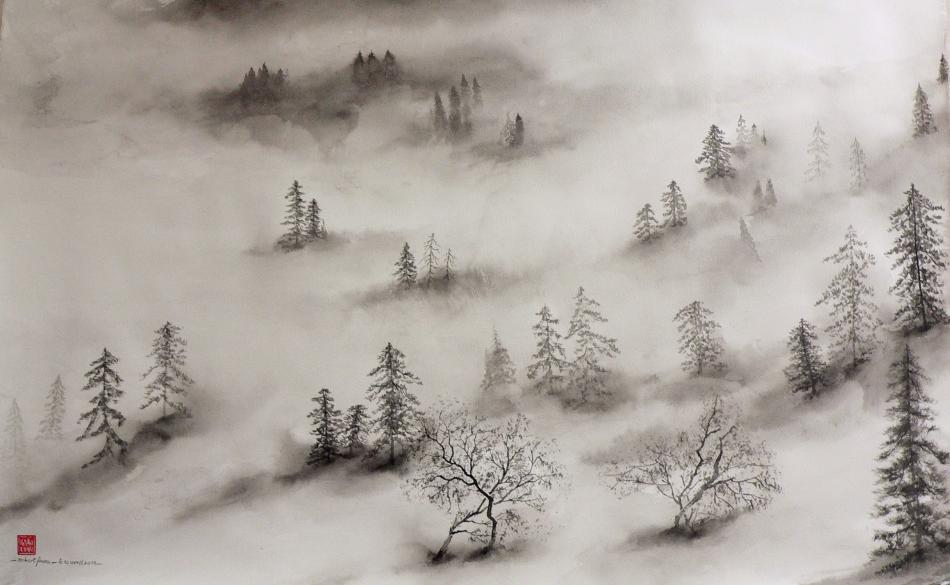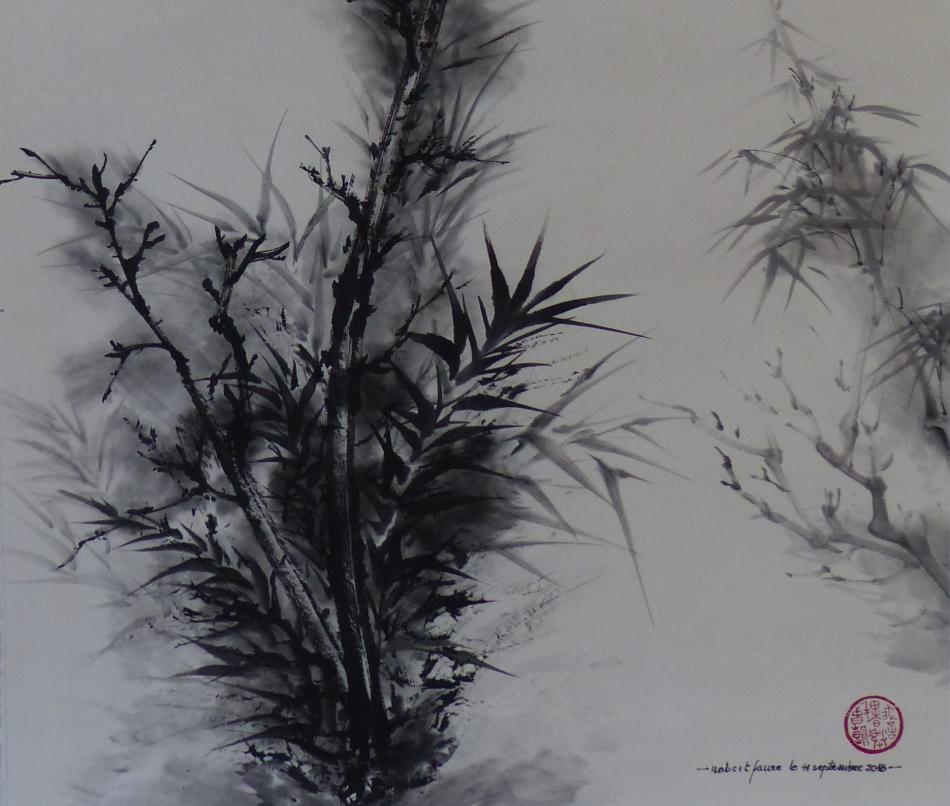The Tch'an art appeared clearly during the Tang period of the Chinese dynasties around the 7th century AD.
The style developed in parallel with other schools of Chinese painting but is recognisable by an extreme soberness and vitality of brush stroke. A stroke which is prepared, much as an archer prepares to shoot, in a moment of silent meditation, so the gesture is determined and without hesitation.
Six centuries later, that art was to penetrate and influence Japan and was taught in numerous centres of Zen learning. It became known simply as sumi-e, meaning painting with ink by the Japanese.
The principal rules set out by China under Xi-He (5th Century AD) have stayed the same to this day: soberness, vivacity, without retouches, the simmering of life is present in each represented subject.
The objective of that painting is not as much an aesthetic research as a personal interior practise, a path leading to the transformation of the perception of the world, men and objects. We find the influence of Taoism whereby the character of one's relationship with nature conditions one's human life.
The master pieces of tch\'an ou sumi-e are countless and that art has promoted both research and grand concentration, a purification of the brush stroke and the possibility of personal audacity.
" the master pieces of tch\'an art are petrified passion in a moment of calm stupefaction".
 |
| Avalanche de brumes © |
From the simplest of resemblances to the most expressive creations, both rich in details and colours, Chinese painting has passed through stages from the most austere to the most shimmering and lyrical. The meeting in the 6th century with Buddhism culture from India was to influence numerous artists in a very particular fashion through the centuries. In the way one looks at nature, the traditional Chinese Taoism joined little by little a particular echo in Buddhist doctrine called tch'an in Chinese and better known as Zen in Japan. Each aspect, each element, each parcel of nature is unique and respectable in the hidden interior energy.
Around the 12th and 13th century, the practise of tch'an painting accords an important place to meditation on what is real, concrete and natural before painting.
Several adepts of Tch'an such as Mu-Qi and Liang Kai practised painting with vigour and dexterity in their brush stokes after long minutes of silence.
Their practises were based on ethical life practises and a discipline which developed not only the technical aspects of painting with ink but a clarification of their interior life, also inspired by Taoism.
Tch'an art has promoted both research and grand concentration, a purification of the brush stroke and the possibility of personal audacity.
That art has opened the way towards a more instantaneous painting, primarily serving personal inspiration and spiritual intuition. The breach dividing concrete reality and the spiritual vision of all things is smoothed away. Tch'an painting has been one of the most complete expressions in Chinese painting and has influenced many generations of artists who by affirming their own personal liberty in regards to passing trends, return to methods that while being voluntarily poor, reveals that which is essential.
 |
| Prunus sauvage © |
From the simplest of resemblances to the most expressive creations, both rich in details and colours, Chinese painting has passed through stages from the most austere to the most shimmering and lyrical. The meeting in the 6th century with Buddhism culture from India was to influence numerous artists in a very particular fashion through the centuries. In the way one looks at nature, the traditional Chinese Taoism joined little by little a particular echo in Buddhist doctrine called tch'an in Chinese and better known as Zen in Japan. Each aspect, each element, each parcel of nature is unique and respectable in the hidden interior energy.
Around the 12th and 13th century, the practise of tch'an painting accords an important place to meditation on what is real, concrete and natural before painting.
Several adepts of Tch'an such as Mu-Qi and Liang Kai practised painting with vigour and dexterity in their brush stokes after long minutes of silence.
Their practises were based on ethical life practises and a discipline which developed not only the technical aspects of painting with ink but a clarification of their interior life, also inspired by Taoism.
Tch'an art has promoted both research and grand concentration, a purification of the brush stroke and the possibility of personal audacity.
That art has opened the way towards a more instantaneous painting, primarily serving personal inspiration and spiritual intuition. The breach dividing concrete reality and the spiritual vision of all things is smoothed away. Tch'an painting has been one of the most complete expressions in Chinese painting and has influenced many generations of artists who by affirming their own personal liberty in regards to passing trends, return to methods that while being voluntarily poor, reveals that which is essential.
It is the same art that was met by such enthusiasm in Japan that in certain Zen Buddhist monasteries it has been practised as a complete and noble discipline.
That art of painting with ink, exclusively black ink and water has been named "sumi-e" meaning literally "drawing with ink", this term is recognised throughout the whole of the Far East.
The true sumi-e style is still recognisable today by its rapid sober execution, reminding one of the instantaneous enlightenment researched for in Buddhism. But that ease allows one to divine a profound capacity for observation permitting the representation of all things in a real and authentic manner.
For hundreds of years, the tch'an or sumi-e painter has been searching to reproduce « the spirit of things » suggesting rather than using detail with economy of movement, rapidity and dexterity.